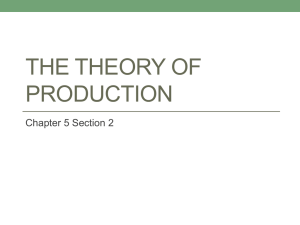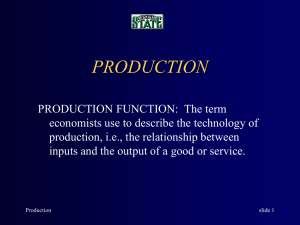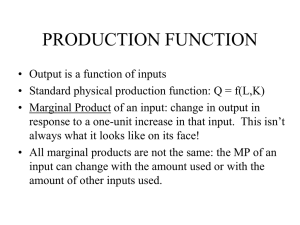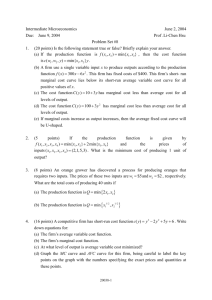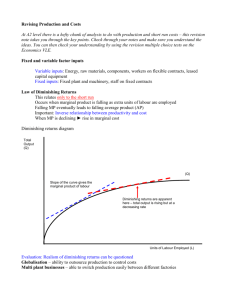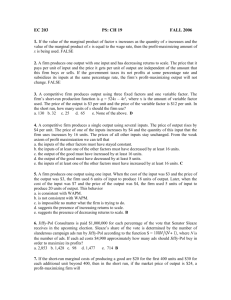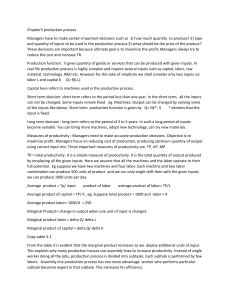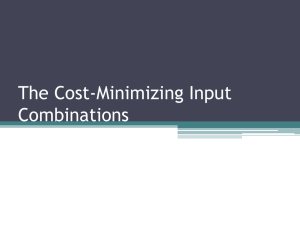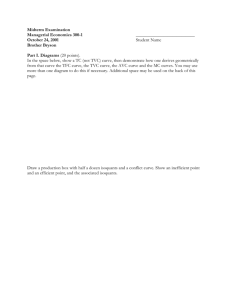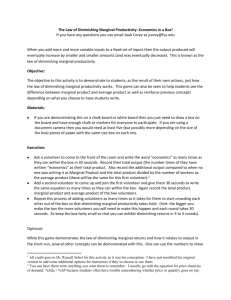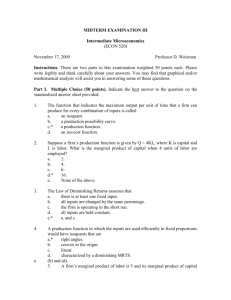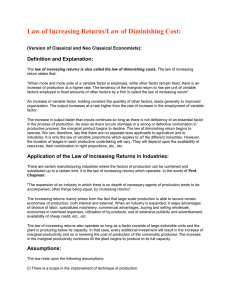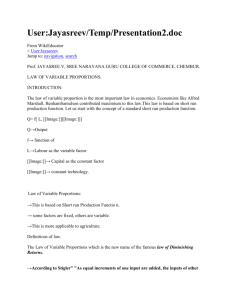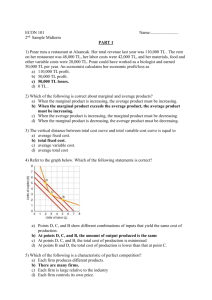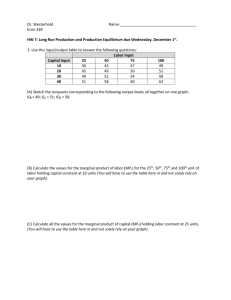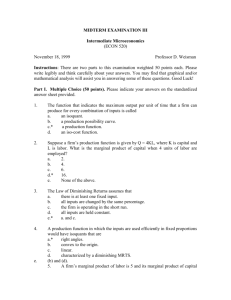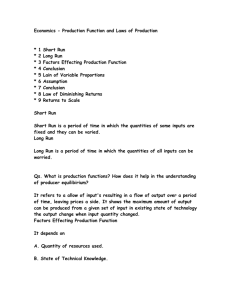WEEK 5
advertisement
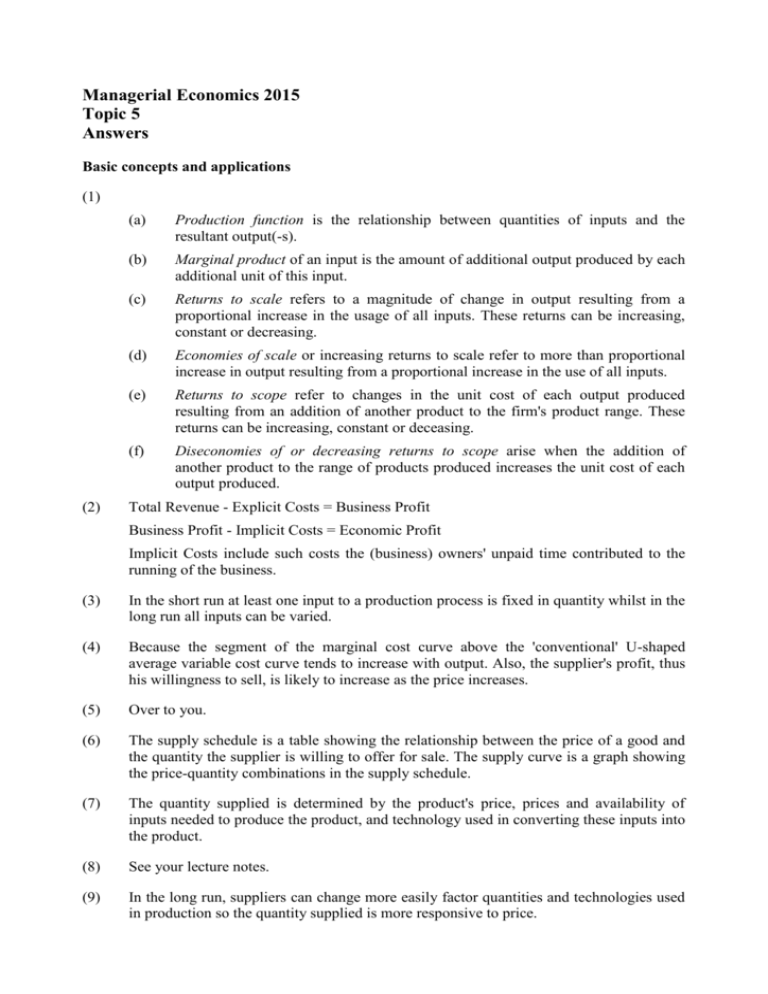
Managerial Economics 2015 Topic 5 Answers Basic concepts and applications (1) (2) (a) Production function is the relationship between quantities of inputs and the resultant output(-s). (b) Marginal product of an input is the amount of additional output produced by each additional unit of this input. (c) Returns to scale refers to a magnitude of change in output resulting from a proportional increase in the usage of all inputs. These returns can be increasing, constant or decreasing. (d) Economies of scale or increasing returns to scale refer to more than proportional increase in output resulting from a proportional increase in the use of all inputs. (e) Returns to scope refer to changes in the unit cost of each output produced resulting from an addition of another product to the firm's product range. These returns can be increasing, constant or deceasing. (f) Diseconomies of or decreasing returns to scope arise when the addition of another product to the range of products produced increases the unit cost of each output produced. Total Revenue - Explicit Costs = Business Profit Business Profit - Implicit Costs = Economic Profit Implicit Costs include such costs the (business) owners' unpaid time contributed to the running of the business. (3) In the short run at least one input to a production process is fixed in quantity whilst in the long run all inputs can be varied. (4) Because the segment of the marginal cost curve above the 'conventional' U-shaped average variable cost curve tends to increase with output. Also, the supplier's profit, thus his willingness to sell, is likely to increase as the price increases. (5) Over to you. (6) The supply schedule is a table showing the relationship between the price of a good and the quantity the supplier is willing to offer for sale. The supply curve is a graph showing the price-quantity combinations in the supply schedule. (7) The quantity supplied is determined by the product's price, prices and availability of inputs needed to produce the product, and technology used in converting these inputs into the product. (8) See your lecture notes. (9) In the long run, suppliers can change more easily factor quantities and technologies used in production so the quantity supplied is more responsive to price. (10) Producer surplus is the area below the price and above the supply curve, which equals the price less the seller's costs. It measures the well-being of sellers (see Lecture Notes). (11) P (a) P (b) Supply * P-Q combination Q Q (12) Mark-up pricing involves adding a percentage either to the price paid by a retailer or to the variable cost of production. (13) (a) Production function: Output Number of operatives Marginal product of labour (b) 0 0 0 10 1 10 20 2 10 28 3 8 35 4 7 41 5 6 46 6 5 Diminishing marginal product sets in with the third operative as the addition of this operative adds only 8 units to the total output whilst the previous two operatives contributed 10 units each. (14) (a) Input Y 20 Output 30 units 10 Output 10 units Input X 5 10 Diminishing Marginal Products: at each output level, a reduction of one input by equal increments requires compensating increase in the other input by progressively larger increments. (b) Input Y 20 Output 20 units 10 Output 10 units Input X 5 10 Constant Marginal Products: at each output level, a reduction of one input by equal increments requires compensating increase in the other input also by equal increments. (15) It leads to a shift in the supply of PCs (change in 'other things equal'). (16) The price elasticity of (physical land or space) in CBDs is very low. The amount of space is geographically restricted in these areas and cannot be increased in response to price. (But cities can expand at the periphery.) Multiple Choice Problems (17) Output TP AP 20 a b Input MP a. b. c. d. Uncertain - possible but inefficient (to the right of b) Uncertain - possible (to the right of a) True False MP = max and AP peaks at a. (18) Output TP AP Input MP a. b. c. d. e. False False False False True (19) Q = 10 X 0.6 Y 0.4 diminishing marginal product for X Q 6 X 0.4 X diminishing marginal product for Y Q 4Y 0.6 Y Q = 10(aX)0.6 (aY)0.4 = 10 a0.6 X0.6 a0.4 Y0.4 = a (10 X0.6 Y0.4) constant returns to scale Thus a change of the quantity of inputs used by a multiple 'a' results in the change of output by the same magnitude. Hence these are constant returns to scale. a. b. c. d. e. (20) False. There are constant returns to scale False. They are substitutes but not perfect substitutes False. They are imperfect substitutes False. See above True. See above Breakeven analysis of costs and revenues allows a firm to determine the output necessary to enter a market. a. b. c. d. e. False False False False True

